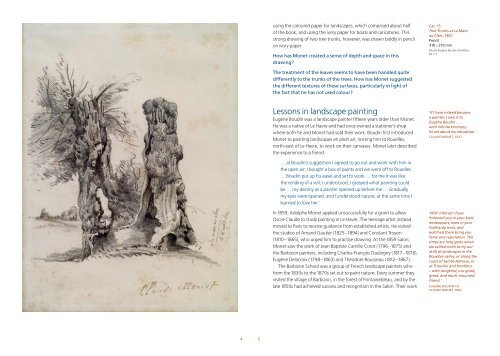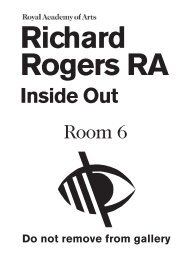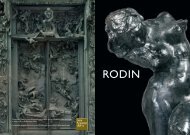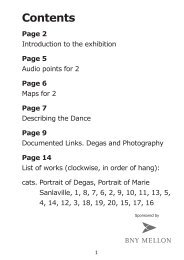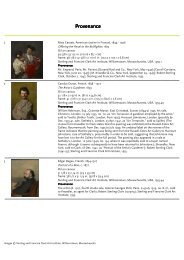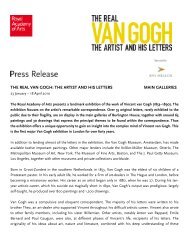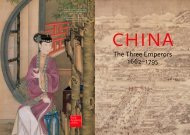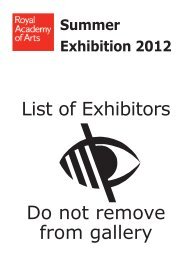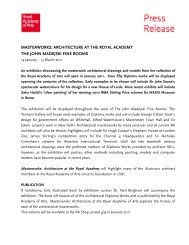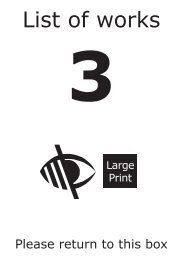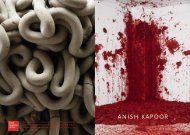Introduction to the Unknown Monet - Royal Academy of Arts
Introduction to the Unknown Monet - Royal Academy of Arts
Introduction to the Unknown Monet - Royal Academy of Arts
Create successful ePaper yourself
Turn your PDF publications into a flip-book with our unique Google optimized e-Paper software.
4<br />
5<br />
using <strong>the</strong> coloured paper for landscapes, which comprised about half<br />
<strong>of</strong> <strong>the</strong> book, and using <strong>the</strong> ivory paper for boats and caricatures. This<br />
strong drawing <strong>of</strong> two tree trunks, however, was drawn boldly in pencil<br />
on ivory paper.<br />
How has <strong>Monet</strong> created a sense <strong>of</strong> depth and space in this<br />
drawing?<br />
The treatment <strong>of</strong> <strong>the</strong> leaves seems <strong>to</strong> have been handled quite<br />
differently <strong>to</strong> <strong>the</strong> trunks <strong>of</strong> <strong>the</strong> trees. How has <strong>Monet</strong> suggested<br />
<strong>the</strong> different textures <strong>of</strong> <strong>the</strong>se surfaces, particularly in light <strong>of</strong><br />
<strong>the</strong> fact that he has not used colour?<br />
Lessons in landscape painting<br />
Eugène Boudin was a landscape painter fifteen years older than <strong>Monet</strong>.<br />
He was a native <strong>of</strong> Le Havre and had once owned a stationer’s shop<br />
where both he and <strong>Monet</strong> had sold <strong>the</strong>ir work. Boudin first introduced<br />
<strong>Monet</strong> <strong>to</strong> painting landscapes en plein air, inviting him <strong>to</strong> Rouelles,<br />
north-east <strong>of</strong> Le Havre, <strong>to</strong> work on <strong>the</strong>ir canvases. <strong>Monet</strong> later described<br />
<strong>the</strong> experience <strong>to</strong> a friend:<br />
… at Boudin’s suggestion I agreed <strong>to</strong> go out and work with him in<br />
<strong>the</strong> open air: I bought a box <strong>of</strong> paints and we went <strong>of</strong>f <strong>to</strong> Rouelles<br />
… Boudin put up his easel and set <strong>to</strong> work … for me it was like<br />
<strong>the</strong> rending <strong>of</strong> a veil; I unders<strong>to</strong>od, I grasped what painting could<br />
be … my destiny as a painter opened up before me … Gradually<br />
my eyes were opened, and I unders<strong>to</strong>od nature; at <strong>the</strong> same time I<br />
learned <strong>to</strong> love her.’<br />
In 1859, Adolphe <strong>Monet</strong> applied unsuccessfully for a grant <strong>to</strong> allow<br />
Oscar-Claude <strong>to</strong> study painting in Le Havre. The teenage artist instead<br />
moved <strong>to</strong> Paris <strong>to</strong> receive guidance from established artists. He visited<br />
<strong>the</strong> studios <strong>of</strong> Amand Gautier (1825–1894) and Constant Troyon<br />
(1810 –1865), who urged him <strong>to</strong> practise drawing. At <strong>the</strong> 1859 Salon,<br />
<strong>Monet</strong> saw <strong>the</strong> work <strong>of</strong> Jean Baptiste Camille Corot (1796–1875) and<br />
<strong>the</strong> Barbizon painters, including Charles-François Daubigny (1817–1878),<br />
Eugène Delacroix (1798–1863) and Théodore Rousseau (1812–1867).<br />
The Barbizon School was a group <strong>of</strong> French landscape painters who<br />
from <strong>the</strong> 1830s <strong>to</strong> <strong>the</strong> 1870s set out <strong>to</strong> paint nature. Every summer <strong>the</strong>y<br />
visited <strong>the</strong> village <strong>of</strong> Barbizon, in <strong>the</strong> forest <strong>of</strong> Fontainebleau, and by <strong>the</strong><br />
late 1850s had achieved success and recognition in <strong>the</strong> Salon. Their work<br />
Cat. 15<br />
Tree Trunks at La Mare<br />
au Clerc, 1857<br />
Pencil<br />
310 × 210 mm<br />
Musée Eugène Boudin, Honfleur,<br />
56.7.1<br />
‘If I have indeed become<br />
a painter, I owe it <strong>to</strong><br />
Eugène Boudin …<br />
with infinite kindness,<br />
he set about my education.’<br />
CLAUDE MONET, 1922<br />
‘With interest I have<br />
followed you in your bold<br />
endeavours, even in your<br />
foolhardy ones, and<br />
watched <strong>the</strong>m bring you<br />
fame and reputation. The<br />
times are long gone when<br />
we sallied forth <strong>to</strong> try our<br />
skills at landscapes in <strong>the</strong><br />
Rouelles valley, or along <strong>the</strong><br />
coast <strong>of</strong> Sainte-Adresse, or<br />
at Trouville and Honfleur<br />
– with Jongkind, our good,<br />
great, and much-mourned<br />
friend.’<br />
EUGÈNE BOUDIN TO<br />
CLAUDE MONET, 1892


